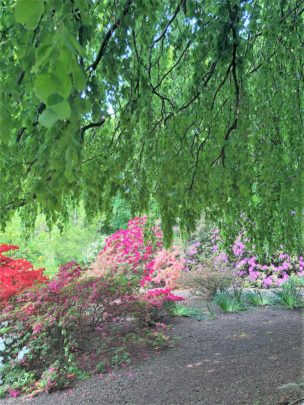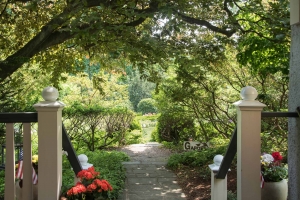Flower City: The University Connection
Re-posted 4/29/23 by the Ellwanger Estate B&B
Posted on by akadri
After the flour boom of the early and mid-19th century died down in Rochester, the city transitioned from being known as the Flour City to worldwide acclaim as the Flower City. This was largely due to horticulturists George Ellwanger and Patrick Barry’s nursery business, which grew from five to over 500 acres between 1840 and 1860, and became the world’s largest nursery in 1888.
Today, much of this land is part of Highland Park, as well as University property, including Goler House, College Town, and various offices. The property also includes the respective residences of the University Provost and President—sites that University Horticulture and Grounds Manager John McIntyre says are utilized for entertaining guests, students, and staff, and are open for public tours. However, what is the significance of this property and its connection to the University, and how has Ellwanger and Barry’s work continued to impact the evolution of the city and the University?
Ellwanger and Barry: plant partners

George Ellwanger was born on a small farm in Germany to a vineyardist whose occupation was jeopardized by the Napoleonic wars, harsh weather, and economic crises. In 1835, after having apprenticed for a leading nurseryman and florist in Stuttgart, Ellwanger set sail for America to seek work. On his way to Ohio through the Erie Canal, he stopped at Rochester to unload freight and was “impressed” by the “then-infant city on the Genesee…for its luxuriant vegetation and its favorable location for a horticultural establishment.” By the spring of 1836, he had bought the nursery portion of the Rochester Seed Store’s business in which he was employed.
Concurrently, Irish immigrant and esteemed horticulture writer and editor Patrick Barry also traveled to America. Arriving in New York in 1836, he gained a foundation in American horticulture at the oldest nursery in the States: the Linnaean Nursery at Flushing, Long Island. In 1840, he headed west, and together, he and Ellwanger saw the potential in the still-growing city. In their 1843 catalogues, they noted that the Rochester climate would help plants adapt to harsh weather, the water channels would make for easy trade, and fresh plantings in the West would safeguard species from diseases in older nurseries.
1840-1888: History of the Ellwanger and Barry Nurseries
To say that the Mount Hope Garden and Nurseries were a success would be an understatement. One of the keys to the business’s success was its relentless expansion—Ellwanger and Barry purchased land almost every year, allowed older plant specimens to mature on older land, and planted new plants on new land. This system allowed them to monitor the progress and quality of each stock, and it established them as both the largest and best-quality nursery in the country.
In addition, the enterprise was one-of-its-kind due to its unparalleled variety in flowers, vines, ornamental shrubs, and most notably, fruit trees. One early visitor called the business “the most complete nurseries on the American continent…in which various species are…so fully and so well represented.” The fruit tree ground alone contained nearly 2000 varieties at that point, with each variety painstakingly-catalogued as per the London Horticultural Society’s method of listing and describing plants.
Ellwanger’s and Barry’s international outlook set them apart. Not only were the products of the nursery sent all over the United States—especially during the post-Civil War era—but they were also exported outside the country. Some reports estimate that the nurseries’ shipments in 1887 were valued at half a million dollars, elevating Rochester to the center of the country and indeed, the world’s horticulture. In addition, Ellwanger and Barry travels to and from Europe helped expand their stock, and a landmark feature of their business was their focus on imports of rare varieties. In their second catalogue, Ellwanger and Barry wrote:
“Our purpose is, and has been since the formation of our establishment, to make, here in WESTERN NEW YORK, a collection of fruits unsurpassed by any in the country, embracing every valuable variety of either native or foreign origin, adapted to our soil and climate.”
Ironically, much of Ellwanger and Barry’s sales contributed to the growth of other nurseries in America and worldwide. This, in addition to the shifting interest from fruits and rare plants to flower and ornamental trees, resulted in a decline in orders. By the 1880’s, seedsmen such as James Vick, Hiram Sibley, and Joseph Harris had introduced mail-orders for customers to order seeds through, much to the chagrin of the nurserymen. Although this expanded Rochester’s reputation as the Flower City, times were a-changing, and Ellwanger and Barry’s business failed to survive past the 80’s.

Present-day: the University connection
For University Horticulture and Grounds Manager John McIntyre, Ellwanger and Barry’s work inadvertently ended up influencing his career choices. He isn’t from Rochester, but he learned about the Ellwanger and Barry Nursery during his time at West Virginia University. He says he “appreciates what Rochester meant to the industry that [he] works in.”
McIntyre admits that the Flower City that Ellwanger and Barry knew is gone. “Land became too valuable—it’s more valuable to have homes and industries that are making money, as opposed to a nursery or garden center,” he said. Yet two buildings stand on University property today that were part of this original legacy. The University’s Patrick Barry House, which currently houses the Provost, was built by designs from English architect Gervase Wheeler and was the home of Patrick Barry until his death in 1890. Additionally, 668 Mt. Hope Avenue currently occupied by University of Rochester Press, was built in 1854 as the office building of the Ellwanger & Barry Nursery.
Ellwanger and Barry’s attempts to beautify Rochester and establish parks and green spaces makes it the city that it is today. Their investment in the development of the Flower City’s horticulture, as well as their contributions to the establishment of public transport, continue to have an enduring impact.
Just as what the duo once created has evolved over the years, so have the needs of the property. For the Horticulture and Grounds team, maintaining the horticultural legacy does not simply mean preserving the nurseries; it also means “doing the best we can, just like Ellwanger and Barry.” Gone are the days of encouraging foreign species; McIntyre notes that many of the plants introduced by Ellwanger and Barry are “now considered invasive in some places.” While the team does make it a goal to plant native plants, they do not opt for invasive species.
Although there are scant remnants of the project that propelled Rochester to international fame, the nursery industry is still integral to the city. McIntyre comments that there are a “lot of really good nurseries and seed suppliers in the area.” Having traveled to various other universities across the mid-Atlantic, he knows that many institutions don’t have the option of buying local. The University of Rochester, on the other hand, “buys local plant material about 99% of the time.” This unique reciprocal relationship speaks to the enduring value for flowers and trees in the area, and illuminates both the University’s role in keeping the Flower City image alive, and Ellwanger and Barry’s long-lasting impact on the city’s identity and industries.
Groups interested in doing walking tours of the Ellwanger and Barry property can contact John McIntyre at jmcinty6@facilities.rochester.edu.
Written by Syeda Mahnoor Raza (’24)
Top Photo: Perennial Gardens, Patrick Barry House (Courtesy of John McIntyre)


 It’s a great day here at the Ellwanger Estate B&B! Jessica has returned to help us out with Meliora Weekend! It just so happens to be this weekend from Thursday, October 4 to Sunday, October 7, 2018! There will be multiple events going on all weekend to include exhibits at the Memorial Art Gallery, University of Rochester Reunion Dinners, Concerts (Pink Martini), and Sport Events. The keynote address is by Soledad O’Brien. Make reservations now so you don’t miss a minute of it!
It’s a great day here at the Ellwanger Estate B&B! Jessica has returned to help us out with Meliora Weekend! It just so happens to be this weekend from Thursday, October 4 to Sunday, October 7, 2018! There will be multiple events going on all weekend to include exhibits at the Memorial Art Gallery, University of Rochester Reunion Dinners, Concerts (Pink Martini), and Sport Events. The keynote address is by Soledad O’Brien. Make reservations now so you don’t miss a minute of it!